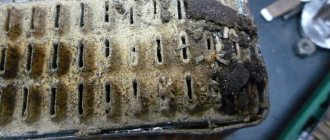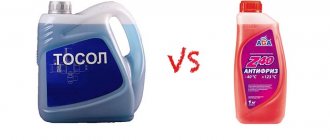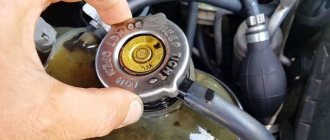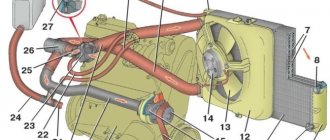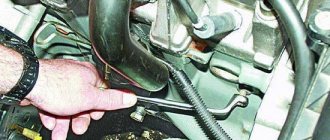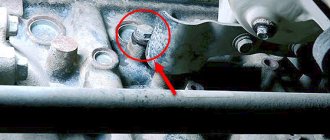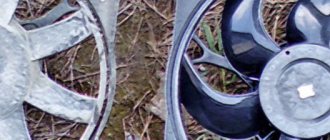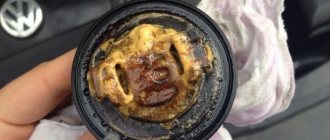Before you start doing anything with SOD, it is advisable to read the main points in this FAQ!
Important information about Kalina-1 SOD is here: https://www.lkforum.ru/showthread.php?t=41258
Diameters of hoses for the entire SOD (internal/external):
Heater radiator inlet hose (upper): 20 mm / 28 mm Heater radiator outlet hose (lower): 18 mm / 28 mm Throttle assembly heating hose (both): 10 mm / 19 mm Expansion tank hose (lower) - 20 mm / 28 mm Engine radiator steam removal hose - 8 mm / 14 mm Fluid supply hose to the engine radiator (upper) - 32 mm / 42 mm Fluid drain hose from the engine radiator (lower) - 36 mm / 46 mm Coolant pump supply pipe hose (bypass) – 32 mm / 42 mm
If you can’t go where you want, go where you can ©
| vovk user menu |
| View profile |
| Find more posts by vovk |
| Read the diary |
I found some good looking reinforced hoses for sale Semperit TU 25 Oil/Air PN 25bar Made in EU
(in a simple rubber goods store opened in the USSR). Now we need to understand whether antifreeze will corrode them.
Please tell me, is it possible to heat antifreeze to a boil (on gas)? Will the purity of the experiment be affected? Is it enough to boil a piece of hose in antifreeze once?
| 15.11.2016, 14:45 | #421 |
| SVSan user menu |
| View profile |
| Find more posts by SVSan |
I found some good looking reinforced hoses for sale Semperit TU 25 Oil/Air PN 25bar Made in EU
(in a simple rubber goods store opened in the USSR). Now we need to understand whether antifreeze will corrode them.
Please tell me, is it possible to heat antifreeze to a boil (on gas)? Will the purity of the experiment be affected? Is it enough to boil a piece of hose in antifreeze once?
A side effect of the operation of an internal combustion engine is heat; it is released due to the combustion of the combustible mixture when interacting with rubbing surfaces. If you do not take measures to remove heat from very hot parts, the entire motor will soon fail. Heat removal in water-cooled motors is carried out using coolant. The circulation pump moves fluid from the cylinder block to the radiator. The thermostat is responsible for quickly warming up to operating temperature; it separates two circuits (small and large). Separating the circuits serves to quickly heat the motor to operating temperature and prevent overheating. To prevent the liquid from boiling, the pump creates pressure in the cooling system. If everything is in order, then during normal operation it is impossible to overheat the power plant even on a summer day. If the temperature gauge needle is in the red zone, you should immediately check all components and mechanisms to avoid failure of the power plant.
Technical features of the system
The unified layout and closed design of the engine cooling system (SOD) of the Kalina are also characteristic of other VAZ models. The system is designed to remove thermal energy from heated engine elements using antifreeze or other coolant.
The SOD consists of the following functional parts.
- Cooling radiator. Reduces coolant temperature due to the flow of cold air masses.
- Fan. Used for rapid cooling of antifreeze in the Kalina cooling system.
- Expansion tank. Designed to compensate for the volume of coolant (coolant). The need for this unit is related to the expansion/constriction property of the coolant.
- A pump or centrifugal pump, which is responsible for the forced circulation of antifreeze through the appropriate channels.
- A thermostat whose task is to regulate the volume of antifreeze in the Kalina cooling system.
- Temperature sensor involved in SOD control.
The operation of the cooling system is based on the close interconnection of various parts, elements and sensors, including devices that are designed to measure oil temperature. The passage of coolant in a large or small circle depends on the engine temperature. In the first case, antifreeze passes through all components of the SOD, except the radiator. With such circulation, the thermostat is closed. As the engine temperature rises, this element gradually opens. The antifreeze, having passed a large circle, enters the radiator. The latter device is cooled by oncoming air masses. If this is not enough, a signal is sent to the ventilated unit, which begins to forcibly direct air masses to the cells.
The cooled liquid enters a small circle. Next, taking into account the engine temperature, the antifreeze automatically circulates in a small or large circle. At the same time, the optimal operating temperature is maintained, which should be in the range of 95-105°C. This factor has a direct impact on the performance of the Kalina stove. In this case, it will not be able to supply warm air masses into the cabin.
If there are any doubts about the operation of the ODS, you need to diagnose the car, finding out the causes of the malfunction. You can fix the breakdown either with your own hands or with the help of a car mechanic.
First, it is recommended to check the antifreeze level in the system. To do this, you will need to open the hood and inspect the expansion tank. It should be filled to 1/2 of the total volume. If necessary, antifreeze is topped up or the coolant is completely replaced. In the latter case, you will need to drain the old antifreeze. If there is a fluid leak, you need to inspect the engine compartment.
conclusions
The design and layout of the cooling system of the Lada Kalina is not much different from its relatives from the rest of the VAZ family. This unit is quite easy to maintain and repair, which allows many motorists to carry out repair operations with their own hands.
Like many Kalinovods, he took up the problem of ventilation of the engine cooling system (ECS). The problem is especially acute in winter. I don’t see any point in explaining why this happens, you can find information about this on any forum, the reason for the appearance of gateways has long been determined by consumers, this is a design error in the development of ODS. I will briefly describe the symptoms on my car: the temperature gauge shows 100-110 degrees and tends to the “red zone”, and cold air comes out of the stove. The limit of patience was a long way, when even at a speed of more than 100 km and -20 outside the window, the engine temperature showed more than 100! You can, of course, endlessly change the caps of the expansion tank (RB) and the thermostat, but that’s what they do in car repair shops... Among the many modifications, I settled on the vf013 proposed by the driver, the concept of a major overhaul was completely taken from him and I will continue to say that this scheme works! Therefore, all technical problems that arise are covered on his page. Thanks vf013)))) So, for me the first problem was that none of the VAZ engineers drew a diagram of the SOD with an EPG (electronic accelerator pedal), the old diagram is everywhere in the accelerator unit (AU), which is heated by two tubes. Rice. 1 Due to the abundance of “extra” pipes, it becomes difficult to understand what, where and why...
Rice. 1. Old remote control circuit, my car has EPG
. Therefore, I had to draw a new diagram with EPG (Fig. 2); it is obvious that the e-gas itself is absent in the diagram, since it is excluded from the engine cooling process.
In Fig. In Fig. Figure 2 shows a hose that wraps around the system used to heat the throttle body, in fact I've always had air in that protrusion...so there's no room for it in the new system. I repeat once again that I did not develop the revision scheme itself, but only modified the vf013 proposal. Here's what I did. Rice. 3
Rice. 3 Modified basic diagram of cleaning and diagnostic equipment
For a better understanding, I immediately removed the “extra” hoses from the picture, which were disassembled after the overhaul. Results: Several days passed and the outside temperature increased or decreased from -2 to -10. I didn’t specifically post the results of the review, because... I was afraid of bringing bad luck on him)))). Immediately after launch, the system came out, I will try to post a video of the process. The engine temperature when driving around the city is always maintained in the working area of 90-95 degrees, while the stove begins to heat up with heat already from 50 degrees! It is clear that this slows down the process of warming up the engine itself, but the fact remains. All costs for major repairs cost about 550 rubles, of which the most expensive antifreeze is 1 liter for refilling, 1 m of hose for connecting to the RB, the rest is all small things: tees, cable ties... I am satisfied with the review and recommend it to anyone who has similar ones Problems. Believe me, when describing such symptoms, the technician at a car service center will say that your thermostat needs to be changed because it is stuck and does not open in the Large Circle, so the temperature is high in the Small Circle, however, this is a dead end, because in my case the thermostat worked properly, this It's easy to check if you want.
Cost: 600 ₽ Mileage: 23,000 km
Having bought a new Granta or Kalina 2, owners are faced with the unusual absence of an engine temperature sensor. They are actually not on the updated models. After diagnosis, many are outraged by the low “operating” engine temperature (77-81 degrees). We hasten to please you - this is not a malfunction of the thermostat or cooling system. This is his "focus".
The following figure shows the hydraulic diagram of the new Kalin engine cooling system.
Here the numbers indicate: 1. Cooling system radiator 2. Engine 3. Pump (water pump) 4. Pump supply pipe 5. Thermostat 2190-1306010 6. Internal heater radiator 7. Expansion tank.
Features of the new system
— a unidirectional radiator with reduced hydraulic resistance made of brazed aluminum with high thermal efficiency, sequentially integrated into the “small circuit” of the cooling system, in contrast to the previous parallel installation of a double-sided radiator;
— Thermostat 2190-1306010 has one, not two valves and only regulates the flow of coolant through the radiator of the cooling system;
— single-sided radiator of the cooling system with low hydraulic resistance.
All this has significantly increased the efficiency of the cooling system.
Various coolant circulation options depending on temperature
Until the thermostat valve opens, all coolant circulation occurs in a small circle through the internal heater radiator. As soon as the temperature rises above the thermostat opening threshold, coolant circulates through the system's large radiator.
In addition, by adjusting the degree of transmission of the thermostatic valve, the engine's "operating" temperature is maintained, which will depend on the characteristics of the thermostat itself. We remind you once again that for the new Kalina the temperature range for opening the valve is from
conclusions
2. The improvement in the consumption properties of cars determines the average temperature of the coolant (77-83 g) of the engines of new cars of the Kalina family (2192, 2194) compared to the previous models Priora, Samara and Kalina cars.
3. Owners of new cars of the Kalina family (2192, 2194) state a fact: the average coolant temperature on their current cars is 7-10 degrees lower than that of the previous Priora, Samara and Kalina models.
4. Maintaining the coolant temperature on cars of the new Kalina family (2192, 2194) in the temperature range below the “normal” on previous models of Priora, Samara and Kalina cars does not lead to increased fuel consumption, increased wear of engine parts or any other negative consequences. Accordingly, in the absence of negative consequences and the absence of coolant temperature standards, “underheating” of the engine is not a discrepancy (defect.
The publication is based on the AVTOVAZ teaching material for PSSS employees. You can find out more about the source material
The weak point of many cars is ventilation of the cooling system and the occurrence of traffic jams, Lada Kalina was no exception. A design flaw requires modernization and modification of the system, especially since this can be done with your own hands.
Coolant or antifreeze passes through the large and small circles, first it must heat up to the desired temperature, and then pass through the radiator. Proper operation of the oven motor and mechanism depends on how well the cooling system works.
The main causes of ODS malfunctions
Coolant leakage is mainly due to the following reasons:
- presence of an old clamp;
- old or broken radiator.
In the first case, the unit is replaced, and in the second, repairs are carried out.
First of all, check the system pipes
Then you will need to check the circulation of fluid in the motor system in question. To do this, you need to see if antifreeze is entering the tank. If the result is negative, then replace the pump or clean the cooling system with special means.
If the Lada Kalina overheats, auto mechanics identify the following reasons for this situation.
- The thermostat has failed. To check its functionality, you need to touch the radiator pipes. If the top element is cold and the bottom element is warm, the thermostat is stuck. In this case, a new unit is installed.
- Clogged honeycombs. This problem usually occurs in late spring and early summer. In such a situation, clean the outer part of the radiator.
- Fan malfunction. If this device does not turn on when the coolant temperature is high, you need to check the wiring and relay.
- Presence of air masses in the SOD.
To solve the last problem, you will need to open the expansion tank. Start the engine, periodically press the gas pedal until the red mark is reached on the sensor. If the fan turns on, then you need to “add gas” by turning off the ignition. If it is not possible to eliminate the airlock using this method, more radical measures are used.
The plastic motor screen will need to be removed. To do this, he rises. Use a screwdriver to lower the clamp. Remove 1 of the 2 fitting tubes. Then remove the expansion tank cap. You need to blow into the container until antifreeze begins to pour out of the dismantled tube.
If it is not possible to break through the container, the lid closes. The tube is put in place. The engine warms up and the ignition turns off. Without dismantling the tank lid, remove the heating tube.
So where should you start?
The first thing you need to do is check the antifreeze level in the system. To do this, open the hood and look at the expansion tank. Ideally, it should be filled to ½ of the total volume. If necessary, add coolant to this level.
If you find an antifreeze leak, then inspect the engine compartment of the car - there may be leaks here.
Important points of improvement
Coolant is considered a toxic substance that adversely affects human health. Auto mechanics recommend draining antifreeze with caution. When carrying out this procedure, you need to remember safety precautions and use rubber gloves. The antifreeze is drained when the engine is cold. Then the tube is put on the fitting, the clamps are tightened. Air masses have been successfully removed from the system under consideration.
Cooling system Lada Kalina: features
The operating temperature of the Kalina engine is up to 103°.
If the temperature is higher, the engine overheats, which means that the driver and his car will face serious troubles: head deflection or (even more depressingly) water hammer.
Overheating of the motor is possible in a situation where one or another cooling element fails. At first, a light phase begins - during which the engine begins to boil.
The consequences may be even more severe. They are characterized by deformation and deflection of the cylinder head. In this case, the situation can be corrected by simply grinding the surface of the latter.
The middle phase is characterized by deformation of engine parts of the same valve mechanism. In the future, the above-mentioned part will require serious repairs: after all, repairing the cylinder head is quite a financially expensive matter.
The heavy phase represents destruction from the strong heat flow of the piston group. Still, this defect is not the worst thing you can expect. But if coolant gets into the car cylinders, the power unit of your car will quite naturally suffer a water hammer. And then a major overhaul may not help.
Functional range of elements of a car cooling system
The standard cooling system consists of the following elements:
- sensors – determine t° in certain auto mechanisms; one of the management elements of the system;
- pump – makes it possible to circulate liquid in the SOD; operates in a forced mode;
- pipes – coolant moves through them;
- expansion tank - compensates for the volume of antifreeze, since due to temperature fluctuations it narrows and expands;
- radiator - a device that discharges excess heat into the environment;
- fan – activates the cooling process by forcing air; With its help, the cooling intensity increases;
- Thermostat - although small, is a very important element that regulates the amount of antifreeze; provides a “comfortable” temperature regime throughout the entire system.
Operating principle
The cooling system operates in a self-regulating mode, which is aimed at maintaining optimal temperature in the power unit. If the oil temperature rises significantly, the system does everything to ensure that the temperature inside the engine decreases.
Thus, with the close interaction of the above elements, the system functions. It automatically sets the necessary conditions for the inclusion and operation of structural parts, which ensures effective cooling of the power unit.
Possible malfunctions of the ODS, diagnostics
Almost always, a breakdown of the cooling function of a car is caused by an antifreeze leak. You should inspect the car under the hood for possible leaks. The cause of the leak may be:
- or a leaky clamp;
- or a radiator failure.
Then in the first case the element is replaced; this is not difficult and does not take long. As for the radiator, it is better to have it repaired. There are also no particular difficulties here: often you just need to solder the holes.
The reasons for overheating of this car can also be:
- thermostat. Its suitability is checked using both pipes: the temperature of the latter should not be sharply different (this is determined on a warm engine). Otherwise, the thermostat is faulty and antifreeze circulates in a small circle;
- clogging of radiator honeycombs. You can solve the problem by cleaning the outside of this element. Often this is not always easy to do, but there are no other methods other than manually cleaning the honeycombs;
- Fan malfunction. When the heating level of the coolant increases, this part should begin to operate. If this does not happen, check the relay, wiring or t° sensor;
- air in the coolant system. Lada Kalina is not insured, among other things, against the so-called air lock inside the system. In general, previous types of breakdowns are eliminated quite quickly and almost everything is clear with them. In the latter case, it is necessary to understand in more detail. The question - how to remove air from the Kalina cooling system - is really very important for the optimal functioning of the totality of the elements of this car.
Airlock
If the cooling system becomes airy, you need to do the following: with the expansion tank cap open, start the power unit, squeezing the gas pedal from time to time, warm it up until the t° sensor “reaches” the red scale. After “starting” the ventilation device, “add up the gas” a little more and then you can turn off the ignition.
If the cooling system is still leaking air and the above measures have not led to anything, you should act more radically. What needs to be done to remove air from the cooling system?
First, remove the power motor screen (dismantling is done in an upward direction).
Loosen the clamp with a screwdriver and remove one of the tubes from the heating fitting of the throttle assembly.
Unscrew the cap of the expansion tank. Cover the neck of the opened container with a clean piece of cloth. Now blow into the tank: coolant should flow from the tube that was removed. If you fail to break through the above container, close the lid and place the tube in its place.
Next, warm up the engine again and turn off the ignition. Then the tube must be removed again, without removing the lid from the tank, and wait until the antifreeze flows.
Since this liquid is very poisonous and dangerous for people, drain the coolant with extreme caution. Remember about safety: get rubber gloves. Monitor the temperature of the tubes. Keep in mind that you only need to drain the coolant when the engine has cooled down.
Now the tube is put on the fitting, the clamps are tightened. At this stage, the problem of how to remove air from the cooling system of the car has been successfully solved. As you can see, it is possible to eliminate faults in the ODS without the participation of professionals.
SOD Lada Kalina in a certain sense requires improvement.
At the moment, there are the following methods to improve it:
- rework. The car is equipped with a new thermostat. Thus, the temperature of the antifreeze will become stable, and the activity of the interior heating elements will return to normal;
- to minimize coolant malfunction, the machine is equipped with a coolant filter;
- an additional pump in the above-mentioned power unit system. This will force the antifreeze to circulate through the appropriate channels faster, which will definitely reduce engine overheating. And a plus - in cold weather you will not freeze in the car.
Everything that may be important for a motorist on the above topics regarding the Kalina car: what the Lada Kalina heating system is, as well as airing the cooling system, why the cooling system will air, how to remove air from the cooling system, possible malfunctions, necessary alterations more clearly will tell the presented video.
Causes of ODS malfunction
Modification of the cooling system on the Lada Kalina can be done either on your own or at a car service center. However, in the latter option, experts usually recommend replacing or repairing the thermostat, which is not always practical or effective. The main causes of problems in the cooling system:
- Coolant leak. It is recommended to check the clamps and integrity of the radiator. If necessary, elements are replaced or repaired. You can check the circulation of refrigerant in the system by making sure that liquid enters the tank. If this does not happen, you should replace the pump or clean the SOD with special means;
- Failure of the thermostat or its elements;
- Contamination of radiator honeycombs;
- Fan malfunction;
- Presence of air pockets in the system.
Let's sum it up
So we figured out why there is pressure in the engine cooling system, why it can be excessively high or, conversely, low. There is often nothing complicated about checking it yourself, although a lot depends on the car. For example, it happens that the coolant temperature sensor fails. It can provide incorrect data to control devices, thereby misleading the driver. It can show both a high temperature of the power unit and, conversely, a low one. But this will not mean that the system is not working correctly.
If there are any breakdowns in the cooling system, they must be repaired as soon as possible. It is advisable not to operate a vehicle with a stuck cover or thermostat. After all, for some engines overheating is fatal, and major repairs are not cheap at all. In general, it is worth regularly checking the coolant level in the system to ensure that there are no leaks or other defects. It is also recommended to periodically clean the radiators from dirt, as this can cause increased engine temperature.
Traditional Troubleshooting Methods
To solve the problem of airing, you should open the expansion tank, start the engine, press the gas pedal several times until the sensor arrow reaches the red zone. If the fan turns on, you need to squeeze the gas all the way several times and turn off the ignition. If this method is ineffective, the following procedure is used. The plastic motor protection is removed, the clamp is lowered and one of the fitting tubes is dismantled. The expansion tank cap is opened and the system is purged until coolant begins to pour out of the removed tube.
A standard modification to the cooling system involves installing a new 6-hole thermostat, coolant filter and heater valve. To maximize coolant flow and minimize the risk of overheating, you will need to install an additional pump.
Traditional methods of improvement
In the version with an electronic gas pedal, the cooling system is looped with a hose that was previously used to heat the throttle assembly. Using an additional hose, tee and clamps, a connection of a smaller diameter is mounted to vent the system. The air vent is installed as close as possible to the thermostat using a tee cut into the supply hose to the radiator.
The second end of the air outlet element is connected to the steam outlet near the RB fitting (using another tee). This modernization made it possible to achieve a stable temperature of 90-95°C when driving around the city, with the stove starting to warm up at 50°C. The costs for additional elements (refilling refrigerant, tees, clamps and 1 m of hose) amounted to about 600 rubles. It is worth noting that before the upgrade, the sensor showed the engine temperature was more than 100°C, while cold air was blowing from the stove.
Second way
modification of the SOD consists of installing a hydraulic intake on the steam outlet. To do this, a regular tube from a dropper is inserted into the steam exhaust channel with constant immersion in the coolant and touching the bottom of the tank. While cooling, the liquid will be drawn into the outlet hose according to the principle of communicating vessels, which will protect the system from the formation of air locks. Alternatively, you can combine both methods.
Replacing the thermostat on Kalina 8 valves
The thermostat on Kalina consists of 2 parts - the so-called thermostat cover and housing. The cover is the part in which the thermocouple is located, and the housing is the part that is attached to the engine. Housings are not sold separately, unlike covers, at least I haven’t seen them. Therefore, you can either replace the cover or buy a completely assembled thermostat.
It is attached to the engine with 2 nuts along with the ground wire from the battery. We unscrew them and remove the thermostat. In most cases, the remaining gasket will stick to the engine. They will need to be removed with a knife or blade.
The coolant temperature sensor is screwed into the thermostat housing. You need to unscrew it from the old one and screw it into the new thermostat, or just buy a new one. It is attached under a copper gasket, which seems to need to be replaced with a new one, but practice shows that a used one also holds up normally. The thread of the sensor itself, closer to the gasket, can be lightly coated with sealant.
To be sure, I additionally applied a thin layer of sealant to the new thermostat gasket and installed it in the prepared place. According to reviews on the Internet, it is best to buy an original thermostat from AvtoVAZ. He will last the longest. In second place, this is exactly what I bought, since I simply couldn’t find the original one. Some samples may open not at 85 degrees, but at 90-95º. Not sure if this is normal. It should also be noted that the PRAMO thermostat cover will not fit into the AvtoVAZ body; the side will interfere, which the craftsmen successfully saw off with a grinder.
Replacing the pipes of the Kalina cooling system can be divided into replacing the heater pipes and replacing the radiator pipes. There are 2 pipes suitable for the stove - inlet (1) and outlet (2). There is also an inlet (3) and outlet (4) to the radiator. There is also a small connecting pipe (5) from the thermostat to the siphon.
Eliminating air pockets in the radiator
Since the system in question is absolutely sealed, getting rid of air is not so easy. The car must be placed on any inclined surface with the front facing up (the steeper, the more effective). You should warm up the power unit until the second circulation circle opens, move the temperature regulator to the maximum position, direct the air flow into the cabin and activate the fan at second speed. Next, increasing the engine speed to 4.5-5 thousand, we hold it for some time.
Then the pedal is released until the idle speed appears. If the problem is not completely resolved, the procedure should be repeated.
Despite the fact that modern domestic cars have updated characteristics, some factory defects are still present. Modification of the cooling system on the Lada Kalina is available in several ways and helps to avoid the formation of air locks. Moreover, the procedure does not require significant financial investment.
Dynamics and handling
There is no data on this, but the 4x2 formula indicates a lack of off-road characteristics. The ground clearance of these cars is quite high: 160 and 180 mm, respectively, so light off-road conditions will not be a problem for them. Unless, of course, after a long stay the wheels don’t get stuck and spin. Security comes with several options. It is also possible to install an alcohol lock, which will prevent the engine from starting if vapors are present. The cars are equipped with standard solutions, including child seat mounts and keyless engine starting. In more expensive trim levels you can find a higher level of alarm than in previous models.
